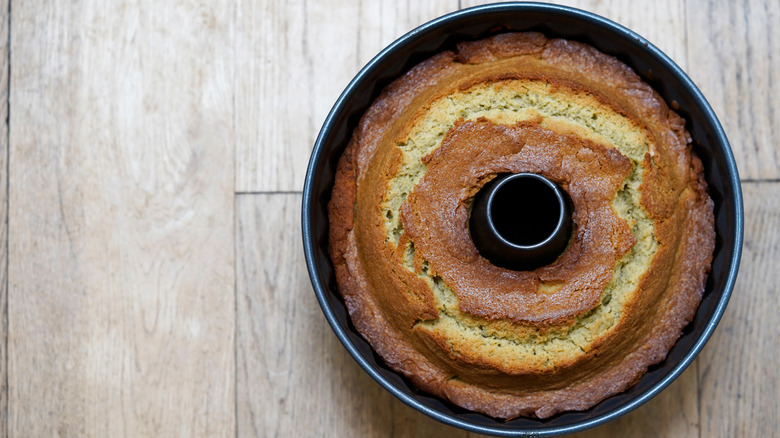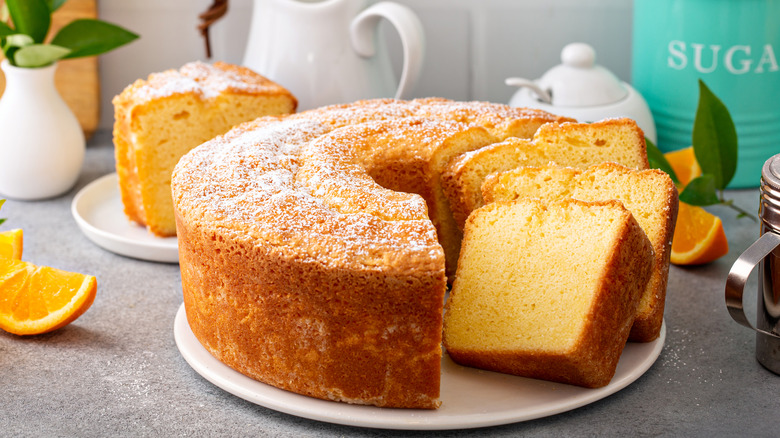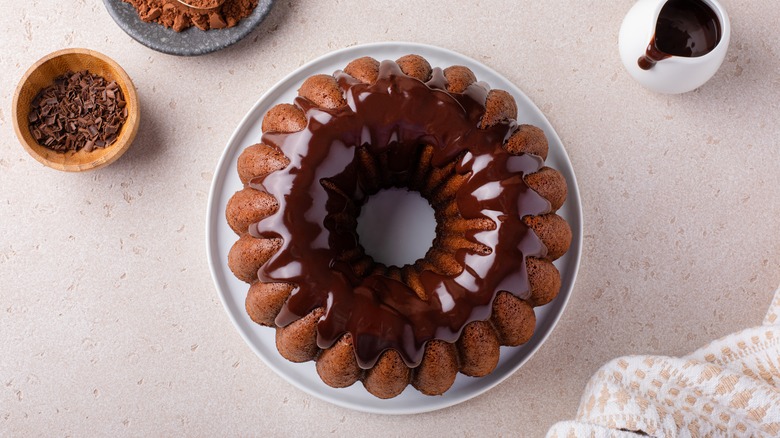Tube Cake Pans Vs Bundt Pans: What's The Difference?
Selecting the correct pan to bake a cake is just as important as the ingredients and the preparation. The materials and shape of a baking pan or tin can impact the rise, the texture, and the overall impression of a cake. In this sense, choosing a pan that's fit for purpose is essential. Tube cake pans and Bundt pans may share a similar circular shape and hollow appearance, which showcases how the Bundt pan is actually a descendant of the tube pan. However, their shapes make their applications wholly different. Understanding the differences between these pans is paramount to producing specific cakes the way they are supposed to be enjoyed.
The most apparent difference between the two is the design of the circular pan. The tube cake pan exhibits smooth sides, while the Bundt pan consists of wavy grooves. Both come in a variety of sizes, and the Bundt pan's flutes come in a range of patterns. Yet one of the most significant differences is not entirely clear until a cake enters the fold. The Bundt and tube cake pan lend strength to specific bakes, and you should proceed cautiously if you wish to use them interchangeably.
The case of the tube cake pan
The humble tube pan may look simple, but it's an essential piece of culinary equipment for bakes with a fine, airy crumb. For instance, angel food cake, or Chiffon cake, which has an irresistibly springy texture and impressive rise, must be baked in a tube cake pan. To achieve the ultimate height and consistency, these cakes can be baked in a non-greased pan and then inverted as soon as they are removed from the oven. Combining these steps allows the batter to grip onto the sides of the baking pan and prevent the air bubbles inside the cake from shrinking. Thus, a deflated, disappointing bake is avoided.
The tube pan allows for easy and quick release of these delicate cakes, whether they come with detachable sides, a removable bottom, or a spatula carefully inserted around the smooth sides. The former two elements are never part of a Bundt pan's features. Tube pans may also come with small grips or feet that allow these cakes to be inverted easily. Of course, not all bakes placed into a tube pan need to be ungreased. A prime example may be a pound cake, where the desired finish is smooth and golden. For this, it would be essential to thoroughly grease the entire pan.
Bundt pan at the ready
Bundt pans are ideal if you want to add a wavy, rigid, or rippling pattern around the edge of a cake. For instance, a Bundt pan would marvelously present a pumpkin cake or another bake where a symmetrical design is desired. While the designs on the Bundt pan give an attractive appeal, the deep grooves do not work with cakes with a fragile structure — such as the Chiffon cake.
The Bundt pan's origins are seemingly debated, as some speculation deems the pan's existence in Eastern Europe to be centuries old, while others mark David Dalquist as the inventor in 1950. Yet one thing that is not up for debate is the need to grease a Bundt pan every time before use, even those that claim to be non-stick. Picture attempting to release a bake from an ungreased Bundt pan; it would be a somewhat chaotic and messy affair. Greasing will ensure a cake with a smooth finish. Vegetable shortening and butter can be used to grease the pan; however, the latter can be prone to burn inside the pan and impact the cake's edges and color.
Although you might have once considered tube cake pans and Bundt pans to be closely related, it's essential now to appreciate their differences and create bakes in accordance with this. Your cakes will only prosper.


